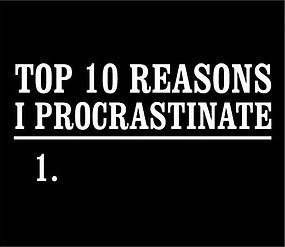So why do we do it? Timothy Pychyl, author of Solving the Procrastination Puzzle (Excellent book – only 100 pages of practical solutions) puts it this way:
“A purely visceral, emotional reaction to something we don’t want to do.”
Pychyl identifies a set of seven triggers that make a task seem more averse. Think of something you are putting off now (there will be more than one thing!) and its likely it will fall into one of these:
-
Boring
-
Frustrating
-
Difficult
-
Ambiguous
-
Unstructured
-
Not intrinsically rewarding (i.e., you don’t find the process fun)
-
Lacking in personal meaning
If we look at this issue from a neurological point of view, our Limbic system (which is the emotional part of the brain and includes the amygdala – the so-called Lizard brain) strong arms the rational and reasonable prefrontal cortex (the Executive brain.) Unfortunately, our prefrontal cortex often surrenders as soon as we have to choose between opening an interesting email and continuing an important report, or between looking at Facebook and writing a difficult email. You get the picture. We can visualise this by considering the limbic system being that guy (or girl) sitting on your shoulder and whispering to you “do that, not this. This is boring, frustrating, difficult etc.” I call it “My FM” – and the volume is always up!
So how do we minimise it? And remember we are attempting to change the natural operation of our brain here, millions of years of evolution, so this will not be easy and it could take some time!
-
Try to reverse the triggers. Think differently ( I like that!) about those triggers and try to make the idea of completing the task more attractive. For example if you are writing a complex report do it in spurts of 15 minutes, then get up and take a 5 minute walk. Repeat! The 15 minutes of focus will give you the feeling of progress
-
Work within your resistance level. This is linked to number 1. Find the period of time you can do the task prior to reaching your resistance level – prior to the point were you start to think about other things. Everyone is different – it may be 20 minutes, 50 minutes, whatever. Once you have found that point, where you start to think of other stuff and get distracted by it, stop. Make sure you don’t reach that point next time
-
Do something – anything – to get started. This is the most practical solution for me. Get over that initial hump of starting it, then it will never seem as difficult or complex as what you thought it was. Interestingly, research has found that we remember uncompleted or interrupted tasks better than ones we have completed. Its like listening to a well known song that gets suddenly interrupted, we can’t get it out of our heads for the rest of the day! Starting a task usually means you will continue to process it, and you will find it easier to go back to it later
-
Disconnect. Those smartphones, iPads, PC’s. Stop those distractions. Distractions just make it easier to stop what you are meant to be doing and do something more enjoyable
Being aware of that double horned devil of procrastination is the real key though. Accept that we are all affected by it, and work at decreasing it. There has been vast amounts of research around quantifying the truly productive time of our working day – and you know it will shock you so I won’t mention it! Other than to say, if you want to be productive for 4 hours out of 8 you will be above the average!
Be well, stay focused and don’t procrastinate (too much!)
Cheers
Phil Pickford


